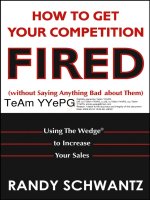using investor relations to maximize equity valuation
Bạn đang xem bản rút gọn của tài liệu. Xem và tải ngay bản đầy đủ của tài liệu tại đây (2.03 MB, 287 trang )
TeAM
YYeP
G
Digitally signed by
TeAM YYePG
DN: cn=TeAM YYePG,
c=US, o=TeAM
YYePG, ou=TeAM
YYePG,
email=yyepg@msn.
com
Reason: I attest to the
accuracy and integrity
of this document
Date: 2005.06.11
05:47:15 +08'00'
Using Investor Relations
to Maximize
Equity
Valuation
p0 ryan fm 9/23/04 2:38 PM Page i
Founded in 1807, John Wiley & Sons is the oldest independent publishing
company in the United States. With offices in North America, Europe, Aus-
tralia, and Asia, Wiley is globally committed to developing and marketing
print and electronic products and services for our customers’ professional
and personal knowledge and understanding.
The Wiley Finance series contains books written specifically for finance
and investment professionals as well as sophisticated individual investors
and their financial advisors. Book topics range from portfolio management
to e-commerce, risk management, financial engineering, valuation, and fi-
nancial instrument analysis, as well as much more.
For a list of available titles, visit our Web site at www.WileyFinance.com.
p0 ryan fm 9/23/04 2:38 PM Page ii
John Wiley & Sons, Inc.
Using Investor Relations
to Maximize
Equity
Valuation
THOMAS M. RYAN
CHAD A. JACOBS
p0 ryan fm 9/23/04 2:38 PM Page iii
Copyright © 2005 by Thomas M. Ryan and Chad A. Jacobs. All rights reserved.
Published by John Wiley & Sons, Inc., Hoboken, New Jersey.
Published simultaneously in Canada.
No part of this publication may be reproduced, stored in a retrieval system, or transmitted in
any form or by any means, electronic, mechanical, photocopying, recording, scanning, or
otherwise, except as permitted under Section 107 or 108 of the 1976 United States Copyright
Act, without either the prior written permission of the Publisher, or authorization through
payment of the appropriate per-copy fee to the Copyright Clearance Center, Inc., 222
Rosewood Drive, Danvers, MA 01923, 978-750-8400, fax 978-750-4470, or on the web at
www.copyright.com. Requests to the Publisher for permission should be addressed to the
Permissions Department, John Wiley & Sons, Inc., 111 River Street, Hoboken, NJ 07030,
201-748-6011, fax 201-748-6008, e-mail:
Limit of Liability/Disclaimer of Warranty: While the publisher and author have used their best
efforts in preparing this book, they make no representations or warranties with respect to the
accuracy or completeness of the contents of this book and specifically disclaim any implied
warranties of merchantability or fitness for a particular purpose. No warranty may be cre-
ated or extended by sales representatives or written sales materials. The advice and strategies
contained herein may not be suitable for your situation. You should consult with a profes-
sional where appropriate. Neither the publisher nor author shall be liable for any loss of
profit or any other commercial damages, including but not limited to special, incidental, con-
sequential, or other damages.
For general information on our other products and services, or technical support, please
contact our Customer Care Department within the United States at 800-762-2974, outside
the United States at 317-572-3993 or fax 317-572-4002.
Wiley also publishes its books in a variety of electronic formats. Some content that appears in
print may not be available in electronic books.
For more information about Wiley products, visit our web site at www.wiley.com.
Library of Congress Cataloging-in-Publication Data
Ryan, Thomas M., 1964–
Using investor relations to maximize equity valuation / Thomas M. Ryan and
Chad A. Jacobs.
p. cm.—(Wiley finance series)
ISBN 0-471-67852-X (cloth)
1. Corporations—Valuation. 2. Corporations—Investor relations. 3. Investment
analysis. I. Jacobs, Chad A., 1964– II. Title. III. Series.
HG4028.V3R93 2005
659.2'85—dc
2004020700
Printed in the United States of America.
10 9 8 7 6 5 4 3 2 1
p0 ryan fm 9/23/04 2:38 PM Page iv
v
Contents
PREFACE
A Brave New World of Investor Relations ix
INTRODUCTION
A New Approach and Why It’s Important xiii
PART ONE
Capital Markets and Their Players: A Brief Primer 1
CHAPTER 1
The Capital Markets and IR 3
CHAPTER 2
The Sell-Side Disclosed: Who They Are and What They Do 13
CHAPTER 3
The Buy-Side: Institutional and Retail Investors 21
CHAPTER 4
Employees, Suppliers, Customers 25
CHAPTER 5
The Media 29
PART TWO
Post-Bubble Communications: Events in the Markets
and the New World of IR 33
p0 ryan fm 9/23/04 2:38 PM Page v
CHAPTER 6
Greed Is Good, ’90s Style 35
CHAPTER 7
Of Rules and Regulations 39
CHAPTER 8
Post-Bubble Reality 45
CHAPTER 9
Of Reason, Renewal, and Honesty 51
PART THREE
Investor Relations—The Fundamentals: Traditional IR
and the Need for Change 59
CHAPTER 10
Traditional IR: What It Is, and Why It’s Not Enough 61
CHAPTER 11
Staffing and Sourcing the New IR 73
CHAPTER 12
Grasping the IR Evolution 79
PART FOUR
Investor Relations—Maximizing Equity Value
CHAPTER 13
Positioning IR to Succeed 87
PART FIVE
Definition 99
CHAPTER 14
The IR Audit 101
vi CONTENTS
p0 ryan fm 9/23/04 2:38 PM Page vi
CHAPTER 15
Excavating Value Post-Audit 113
PART SIX
Delivery 121
CHAPTER 16
To Guide or Not to Guide: That Is the Question 123
CHAPTER 17
Targeting the Audience 137
CHAPTER 18
Integrating with PR 147
CHAPTER 19
Infrastructure/Disclosure Check 157
CHAPTER 20
Delivering the Goods 161
PART SEVEN
Dialogue 191
CHAPTER 21
From Delivery to Dialogue 193
CHAPTER 22
Maintaining and Building Relationships 197
CHAPTER 23
Meeting The Street 205
CHAPTER 24
Event Management 213
CHAPTER 25
The Banker Mentality 233
Contents vii
p0 ryan fm 9/23/04 2:38 PM Page vii
CONCLUSION
A Call for Change 245
APPENDIX A
Two Press Releases 249
APPENDIX B
The Conference Call Script 255
APPENDIX C
Velocity Inc. 2004 Investor Relations Plan 261
INDEX 267
viii CONTENTS
p0 ryan fm 9/23/04 2:38 PM Page viii
Preface
A Brave New World
of Investor Relations
I
f a chief executive officer or chief financial officer wanted to hire an outside
agency to help management more effectively interact with sell-side analysts,
investment bankers, and portfolio managers, it would seem obvious that the
best person to hire, especially if the shareholder implication of the decision
were really thought through, would be someone who had senior-level, first-
hand experience as a sell-side analyst, an investment banker, or portfolio
manager. At least that’s our view, one that seemed obvious. Yet, almost every
day, corporate America’s best management teams make the decision to put
investor relations in the hands of professionals who don’t have the appro-
priate background.
Choosing the wrong investor relations support can add risk to the al-
ready risky business of dealing with Wall Street. After almost a decade of
seeing corporate communication blunders that lose shareholders billions of
dollars in value, we became convinced of the tremendous need for a more
professional, strategic, and capable approach to IR.
Along with John Flanagan, our lawyer and founding partner, we started
Integrated Corporate Relations in 1998 in a small office above an antiques
store in Westport, Connecticut. We’d both been senior-level equity analysts
on Wall Street and covered exciting industries while enjoying the opportu-
nity to become experts on specific companies and industry sectors. Similar
to most equity research analysts during the 1990s, we worked long hours
under stressful conditions to be the go-to guys who knew the companies, the
management teams, and the underlying fundamentals that would presum-
ably move our stocks.
As analysts, our job was to take information, both distributed by the
company and that which we uncovered, and conduct in-depth analyses of
these businesses and their earnings potential. During that process, however,
we often found a costly communications disconnect that invariably penal-
ix
p0 ryan fm 9/23/04 2:38 PM Page ix
x PREFACE
ized the companies (in terms of valuation and cost of capital) and investors
(in terms of declining share price).
The culprit? The problem was nothing more than a general lack of ex-
pertise on the part of management teams with regard to dealing with The
Street and managing the nuances of the stock market. All too often, there
was unnecessary confusion, uncertainty, and caution, leading to an arbitrage
between reality and perception.
During that process we frequently witnessed management teams strug-
gle with interacting and communicating with The Street, and we realized
that if we were privy to the details of any given situation, we could really
make a difference. That’s why we crossed the capital markets divide, so that
we could help transform not only the perception of investor relations, but
also its importance to a company’s long-term success.
As former analysts, we saw the complicated relationship between cor-
porations and the investment community and realized we were probably the
best-qualified third party to give counsel on strategic IR issues. This type of
advice was certainly not the job of legal counsel, who most likely never had
spoken to an analyst or portfolio manager as part of his or her job. Nor was
it the task of the big accounting firms that advised CFOs on other important
reporting issues. Most importantly, we strongly believed that it wasn’t the
job of a third-party public relations firm, staffed in all likelihood with PR ex-
perts and communications majors. While these professionals may be at the
top of their game in many communications-oriented situations, they simply
don’t have the background to advise management teams on complex capital
markets–based, strategic IR issues. Nonetheless, this type of firm was domi-
nant in the business of investor relations although there is no guarantee that
the landscape will remain that way.
We came to IR because we believe that former sell-side analysts and
portfolio managers have the unique experience to advise CEOs and CFOs
on how to deal with the markets. As analysts, we understand how research,
investment banking, and sales and trading coexist and interlock to drive
profits at investment banks. Understanding this point is critical to position-
ing a company and advising management on how best to approach any sell-
side firm. We also understand exactly what portfolio managers are looking
for, and how it can change from quarter to quarter. In essence, we package
the product for the sell-side and the buy-side (the buyers) because we’ve sat
in those seats.
Currently, many CEOs and CFOs dismiss IR as too costly or unneces-
sary. That’s a precarious stance on a communications function that, at its
best, can lower a company’s cost of capital and, at its worst, can destroy
management’s credibility, as well as hundreds of millions of dollars in share-
p0 ryan fm 9/23/04 2:38 PM Page x
holder value. The new world of corporate affairs must position IR at the tip
of the spear, leading the communications strategy to preserve and enhance
corporate value.
We created our company to improve the IR equation. In the past six
years, we’ve gathered an exceptional team of Wall Street sell-side and buy-
side professionals, including our president Don Duffy, a former portfolio
manager, and James Palczynski, a former sell-side analyst. We like to think
that we’re redefining investor relations, and despite a mixed market over the
last few years, our business has flourished. Why? We believe it’s a direct re-
sult of the value proposition a group of former capital markets professionals
can bring to the IR process.
We have also taken a fresh look at the practice of corporate communi-
cations in general and launched a PR group run by Mike Fox and John
Flanagan. We’ve challenged the established practices of many of today’s
largest corporate communications firms that see IR on a lower rung of the
corporate communications ladder. We strongly believe in shaking up that
mind-set. Our view of the world is that IR strategy, focused on long term eq-
uity value, should be a force in all corporate communications decisions, pro-
viding a check and balance to PR issues that, if not handled properly, could
erase market capitalization, and raise a company’s cost of capital.
All of our senior professionals come from Wall Street. We understand
the science and the art of the stock market, and we help corporate executives
better direct their time and money to optimize performance, increase prof-
itability, and spur growth. In our view, the transformation is beginning to
take hold and was accelerated by the bear market in 2000, 2001, and 2002;
corporate malfeasance; stepped-up government regulation; and a renewed
commitment by many to fix the system.
This book is about our approach. We believe that every company exec-
utive and investor relations officer must understand certain basic communi-
cations essentials in order to facilitate efficient capital markets understand-
ing and optimal equity valuation. IR can also play a decisive role in the
competitive performance of private companies. We have helped many pri-
vate companies find a voice on Wall Street without sacrificing the privileges
Preface xi
“Our view of the world is that IR strategy, focused on long-term
equity value, should be a force in all corporate communications
decisions.”
p0 ryan fm 9/23/04 2:38 PM Page xi
xii PREFACE
of being private. Any private company that does not utilize IR in its strategy
is missing out on an opportunity to affect its competitor’s cost of capital and
bolster its reputation with investment banks that could eventually take it
public.
In the following pages we relay the tools we employ to help our clients
maximize equity value. We call it “capital markets advisory,” but in reality
it’s what investor relations ought to be. It starts with definition. In order to
help a company reach its best possible level of performance, one must have
a thorough understanding of what adds value to, and what detracts value
from, a stock. It continues with delivery. Corporations must understand
how sales and trading, research, and investment banking work together, and
how they can take advantage of this understanding to best benefit share-
holders, employees, and the company as a whole. Dialogue rounds out the
process. This book is for the corporate executives, investor relations officers,
analysts, bankers, and investors who want a better understanding of the
process.
As we see it, management needs to gather advice from very experienced
analysts and portfolio managers when trying to navigate the choppy waters
of Wall Street. IR practices at larger agencies have become exposed for what
they are: namely a commodity service frequently incapable of providing so-
lutions for complex capital markets issues. We believe that we’ve come up
with a better mousetrap for IR, and we’re pleased to share our thoughts with
you. We hope you enjoy the book.
Tom Ryan and Chad Jacobs
Westport, Connecticut
May 2004
p0 ryan fm 9/23/04 2:38 PM Page xii
Introduction
A New Approach and Why
It’s Important
E
arnings are coming in low, the CEO’s about to resign, inventory is up, and
the cost of new equipment just doubled. It’s a sure thing where the stock
price is headed, right?
Not necessarily. When it comes to the stock market, Adam Smith’s in-
visible hand has been known to get a gentle tug from a variety of con-
stituencies. There’s the company itself and the information it provides.
There’s the equity research analysts who offer their intelligence and opinions
on the company and the industry. There’s the media and the stories they
present. Rounding out the mix are all of the stakeholders, such as employees
and strategic partners, and the long arms of their actions and opinions.
All of these constituencies influence those most affected by the tug, the
investors. From sophisticated institutions to ordinary individuals, investors
depend on reasonable information upon which they can make sound deci-
sions. The company’s responsibility is to seed the substance and direct the
form of this information, and IR is at the core of this responsibility.
Though the long-term value of a company’s stock correlates reliably to
a company’s long-term financial performance, the short-term price is vital to
keeping cost of capital low and maintaining a competitive advantage. We be-
lieve stock price or equity value, is the tangible consequence of an obvious,
but often mismanaged, equation:
Equity value = Financial performance + How that performance is
interpreted by a variety of constituents
A company’s underlying fundamentals and industry outlook are impor-
tant. The company must understand its strengths and weaknesses in the con-
text of its competitive environment to attract the investors and investment
banks that present the best fit to come along for the long-term journey. How
xiii
p0 ryan fm 9/23/04 2:38 PM Page xiii
xiv INTRODUCTION
that story is told is critical. Packaging the information for each audience
must be done in the same way that gifted executives package and sell their
products. The bottom line is that public companies are in a sense products
to Wall Street, and Wall Street is the market for public companies. Let the
commerce begin.
Information alone does not determine stock price; it’s also the interpre-
tation and perception of that information. Recent stories from The Wall
Street Journal’s What’s News, Business and Finance column read something
like this:
An apparel company said its net income was overstated and that its
third quarter results were lower than reported. Stock slips in a sell-off.
A technology company’s shares fell 10 percent on worries about more
disclosures of accounting irregularities. Finance chief quits.
An entertainment company’s distribution deals are the subject of a
grand jury probe into potential conflicts of interest. Stock price slightly
up on low volume.
An Internet company’s earnings jumped 69 percent and sales surged 84
percent, beating forecasts. But its shares fell in after-hours trading on
high volume.
These examples are certainly a mixed bag with some counterintuitive
market reactions. The most likely reason that the entertainment company’s
stock didn’t move on bad news is the result of a consistent and clear IR strat-
egy and how that strategy managed expectations leading up to the event.
Chances are that the entertainment company’s stock was already down and
that new management dealt with the problem transparently and quickly. Al-
though there may be no catalyst for the stock (as evidenced by the low vol-
ume), the worst is likely over. The news was likely compatible with share-
holder understanding of management’s assumptions regarding future
performance, and that’s exactly the situation that company wanted to be in
given the circumstances.
How about the Internet company? In all likelihood, the company had
been growing quickly and ignored IR while earnings were accelerating, a
common mistake. Without the proper strategy to control the sell-side, esti-
mates and expectations increased, leaving 69 percent earnings growth as a
disappointment. Too bad for the tech company’s management team that was
on the verge of an all-stock takeover of a rival company. Their stock just
plunged, and that acquisition just became materially more expensive or out
of the question altogether.
p0 ryan fm 9/23/04 2:38 PM Page xiv
Introduction xv
The thrust of traditional investor relations has included necessary dis-
closures, such as annual reports and 10-Qs, as well as communications, such
as press releases and conference calls. As most IR professionals and Wall
Street experts know, this approach is not enough. Companies that are in-
creasingly aware of this fact look at IR more strategically than administra-
tively. This strategy shift must include proactive counsel that understands
the capital markets, positions the company properly, and cultivates interest
and investor confidence. The goal is to heighten management credibility,
generate third-party validation, and improve the company’s exposure to po-
tential investors, all to maximize equity value.
IR helps a company devise a strategy and present its story based on
quantitative and qualitative attributes, competitive issues, the industry situ-
ation, and most importantly, the current valuation. In order to do this well,
IR must have the capacity to act as a peer or confidant to the CEO, CFO,
and the board of directors. Additionally, IR must advise on a variety of is-
sues from union relations to project development to dividend yields to crisis
management. IR must be able to solve problems and communicate issues in
the context of shareholder value, and do it quickly. This is the language of
the CEO, and it’s the basis on which he or she is compensated and judged.
And IR can’t talk the CEO’s language unless IR understands valuation and
capital markets. Period.
Part One of this book provides a quick overview of the capital markets,
the arena, its players, and how IR works with all of these areas.
Part Two covers the current environment, including what happened
during the boom and bust, the rules that surfaced, and the regulatory
environment.
Part Three looks at the basics of IR, including administrative and strate-
gic tasks, internal and external communications, and the changes we see
coming.
Part Four presents IR with dimension and reveals the practices that
marry IR, corporate communications, corporate strategy, and ultimately eq-
uity value. In this section we answer:
What goes on in the day of an analyst?
What are the portfolio managers looking for?
How can a company uncover value?
Why is guidance so important?
When is the best time to release earnings announcements?
Why and when should a company ever pre-announce?
How can a teach-in boost a company’s visibility?
p0 ryan fm 9/23/04 2:38 PM Page xv
Why are Wall Street’s morning meetings key to IR strategy?
What are the landmines that CEOs can set off with just one wrong
word?
What is the most effective time for insiders to buy or sell stock?
How can a company best deal with short sellers?
What is plan B if a company can’t get coverage?
How do mid, small, and micro-caps stand out in a crowded field?
When are private companies missing out if they don’t have IR?
How can a company prevent the whisper number?
When is bad news better than no news?
Who’s not being honest, and how can a CEO get real feedback?
IR should be the tip of the spear of any financial communications strat-
egy and help management define the tangible and intangibles of valuation,
deliver a company story, and navigate the nuances of the capital markets di-
alogue to maximize equity value.
In addition, the caliber of a company’s IR and the ability to untangle
complex communications problems must be upgraded and handled by peo-
ple with applicable experience. To us, it seems like common sense. A com-
pany that is going to hire a third party to navigate its course on Wall Street
should retain someone with senior-level Wall Street experience. But then
again, common sense isn’t always so common.
xvi INTRODUCTION
p0 ryan fm 9/23/04 2:38 PM Page xvi
Capital Markets and
Their Players
A Brief Primer
This portion of the book provides a very basic overview of the cap-
ital markets: the arena, its players, and how IR works with all of
these areas. The IR skills and tools necessary to manage this arena
are only briefly presented here, and then discussed in-depth in Part
IV.
One
PART
Capital Markets, Players, Stakeholders, and Influencers
Sell-side
Media
Employees
Government Regulations
Buy-side
p1 ryan 9/13/04 8:44 AM Page 1
p1 ryan 9/13/04 8:44 AM Page 2
3
CHAPTER
1
The Capital Markets
and IR
N
o public company operates in a vacuum. In fact, many people, including
regulators and competitors, generate opinions that can affect a com-
pany’s position in the capital markets. Every decision a company makes,
whether financial, strategic, or operational, ripples into the capital markets
and affects the stock price, the competitive position, or the public’s percep-
tion. Anticipating and assessing the impact of corporate actions on the cap-
ital markets, whether from an acquisition, a change in dividend policy, or a
new product introduction, is the function of investor relations (IR).
The underlying premise of the capital markets is to connect those who
have money with those who need money. However, this match must be made
in a mutually beneficial manner. To that end, the sell-side, the middlemen
and -women, must bring quality companies that need capital to Wall Street
to sell equity or debt to the buy-side, managers of trillions of dollars in cap-
ital. What about companies that already have money and want to grow?
They seek out the sell-side, who can help them acquire or divest of busi-
nesses or divisions. These transactions too must be beneficial to the buy-side,
and to ensure that value is created, shareholders must approve these actions.
So who are the sell-side and the buy-side? The sell-side is made up of
firms like Goldman Sachs, Bank of America Securities, S.G. Cowen, Wa-
chovia, RBC Securities, Merrill Lynch, and Piper Jaffrey, to name a few.
They are known as investment banks or brokerage firms, and they employ
bankers, institutional salespeople, traders, and research analysts. The buy-
side is composed of investors. The majority of these are institutional or pro-
fessional investors, like Fidelity, T. Rowe Price, and Wellington Manage-
ment, and they control huge amounts of money, usually from funds,
endowments, or pensions. Simply put, they are true professionals who invest
p1 ryan 9/13/04 8:44 AM Page 3
on behalf of their clients. Other investors include individuals who put their
own money into the capital markets pot.
Generally speaking, companies that need money can get it in one of
two ways. They can take it in exchange for a piece of the company—that is,
they can sell equity or ownership, by giving the investor shares of stock in
the company. Or they can borrow the money, and pay it back to the in-
vestor with interest, selling the investor debt—for example, bonds. On the
other side of the equation, those who want to invest their money can do so,
again generally speaking, in either stocks or bonds, and there are usually
specialists in each area. (Of course, hybrid financing vehicles, like convert-
ible bonds, are an option, but this discussion focuses just on equity
and debt.)
Equity shares can be traded publicly on either the New York Stock Ex-
change or The American Stock Exchange, which are open auction floors, or
the NASDAQ and Over-The-Counter exchanges, which are buyer-to-seller
negotiated systems. Debt trades publicly on the bond or fixed income mar-
kets. A company that has equity or debt that trades publicly is subject to the
rules and regulations, significantly augmented and expanded in recent years,
of the Securities and Exchange Commission.
INVESTOR RELATIONS, TAKE 1
Publicly traded companies are required to provide certain information to
current and potential investors. This information includes mandated SEC
disclosure documents, such as annual reports, 10-K filings, proxy state-
ments, quarterly 10-Q filings, and 8-Ks that announce unscheduled deci-
sions and actions. Additionally, there are the day-to-day goings-on of the
company, marketing strategies, operational decisions, acquisitions, and
general business fluctuations that, if deemed to be material, can be shared
with investors.
All of these communications are supported by other vehicles such as
4 CAPITAL MARKETS AND THEIR PLAYERS
Though the SEC does not have a specific definition for material infor-
mation, the term is generally interpreted to mean anything that would
affect the understanding and decision making of an investor—i.e. any-
thing that would cause a rational investor to act.
p1 ryan 9/13/04 8:44 AM Page 4
press releases, conference calls, and management presentations, whether live
or Web cast.
In most cases, the packaging and distribution of this information is the
responsibility of investor relations, as IR is the filter through which all fi-
nancial communications come out of the company. (See Figure 1.1.)
Companies have either an IR department or an executive designated
with IR responsibilities, and many companies supplement the IR function
with outside IR counsel. IR counsel, either internal or external, not only ad-
ministrates disclosure responsibilities but, in a perfect world, works to pre-
serve or enhance the company’s equity value. IR counsel steeped in capital
markets know-how and industry-specific knowledge understands the cause
and effect of stock movements and incorporates that knowledge into all
strategic communications plans.
STOCK PRICES
Stock price, or equity value per share, moves up and down on company-spe-
cific financial results, macro- and micro-economic influences, and investor
perception of the company. Digging deeper, however, stocks move for two
main reasons: performance, both past (actual) and future (expected), and the
way that performance is communicated and perceived.
A buoyant stock price is critical for any company because it can create
opportunity in the form of a second currency beyond just cash to buy other
companies. It can also attract the best employees and vendors and improve
the morale of the entire organization. Many institutional investors only in-
vest in stocks with large market capitalizations—that is, greater than $1 bil-
The Capital Markets and IR 5
FIGURE 1.1 The Financial Communciations Filter
Buy-Side
Sell-Side
Customers/Suppliers
Government
Media
Company Message
p1 ryan 9/13/04 8:44 AM Page 5
lion, and sometimes $5 billion. Many investors focus only on large caps be-
cause they view them as having less risk, less volatility, and more liquidity,
which allows big investors to buy and sell rapidly without moving the mar-
ket. Correspondingly, companies want institutional investors to buy stocks
because they usually buy large amounts, increasing liquidity and modifying
volatility.
Companies with fewer shares outstanding often have to fight for expo-
sure and awareness and work hard to support the continued buying and sell-
ing of their shares. Standing out among thousands of publicly traded com-
panies and increase trading volume should be one of the aims of IR.
Exposing the company to a wider range of shareholders can also attract the
sell-side, which, from an investment banking perspective, views a high eq-
uity price as an opportunity to acquire assets for stock rather than cash or
sell more equity to the public to raise cash for operations or debt reduction.
All of these options or opportunities derive from a high stock price and are
examples of a low-cost transactions that benefit shareholders.
COST OF CAPITAL
Though the long-term value of a company’s stock correlates 100 percent to
financial performance, a company’s daily, monthly, or yearly stock price is
important because it determines a company’s cost of capital, and cost of
capital is real money. As everyone knows, it costs money to get money—
usually in the form of interest payments, or selling a piece of the pie. The
cost of debt, or borrowing, is interest paid, and the lower the interest,
the lower the cost of capital. The cost of equity is the price that investors
are willing to pay for each share. In this case, the higher the price per share,
for a constant earnings number, the lower a company’s cost of capital, be-
cause the company will have to issue fewer shares to raise the same amount
of money.
These relatively simple concepts can have a significant impact on the ca-
pacity of companies to generate profits and remain competitive. Keeping
cost of capital low should be a major concern to CEOs and CFOs in running
the business and creating shareholder wealth. It’s a fiduciary obligation.
6 CAPITAL MARKETS AND THEIR PLAYERS
“Digging deeper, however, stocks move for two main reasons: per-
formance, both past (actual) and future (expected), and the way that
performance is communicated and perceived.”
p1 ryan 9/13/04 8:44 AM Page 6
THE VIRTUOUS CYCLE OF A HIGH STOCK PRICE
If the cost of capital is determined by a company’s equity value, it’s pretty
important to maximize that value at any given time. Beyond financial re-
turns, it energizes employees, partners, and vendors; supports important
strategic activities; influences the media; and creates a superior return on in-
vestment to that of one’s competitors. This becomes a virtuous cycle. (See
Figure 1.2.)
Strategic and consistent communication and outreach can have a signif-
icant and positive influence on share price, and therefore the price-to-earn-
ings ratio or any other valuation method. This is because one multiple point
on a company’s market value can be worth tens, or even hundreds, of mil-
lions of dollars. For example, if a company’s stock price is $60 and its earn-
ings are $6 a share, they’re trading at a P/E of 10. If they have 200 million
shares outstanding, the total market capitalization is $12 billion. If the mul-
tiple goes up just one point, to 11, the stock trades at $66 a share, and the
market cap is $13.2 billion, a $1.2 billion increase in value from one multi-
ple point. Strategic positioning and outreach can accomplish that expansion.
VALUATION—THE OBVIOUS AND
THE NOT-SO-OBVIOUS
There are many different types of investors with many different objectives.
Some want growth and look for stocks with high returns and earnings mo-
mentum. Others seek value and purchase stocks they feel are undervalued
The Capital Markets and IR 7
The Weighted Average Cost of Capital
WACC= E/V * Re + D/V * Rd * (1-Tc)
Re = cost of equity
Rd = cost of debt
E = market value company’s equity
D = market value of company’s debt
V = E + D
E/V = equity percentage of capital
D/V = debt percentage of capital
Tc = the corporate tax rate
p1 ryan 9/13/04 8:44 AM Page 7

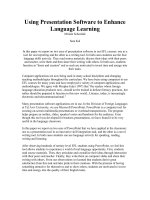
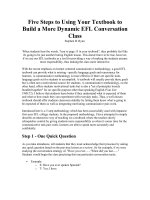
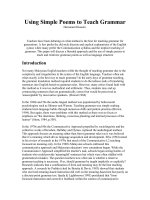

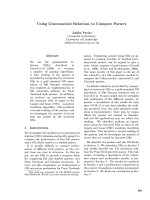
![ipad for kids [electronic resource] using the ipad to play and learn](https://media.store123doc.com/images/document/14/y/pi/medium_pip1401383474.jpg)
